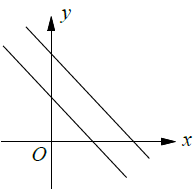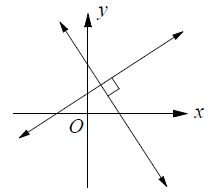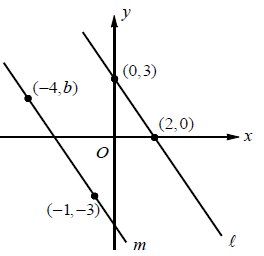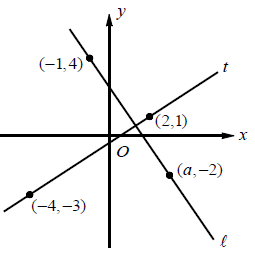FIND MISSING COORDINATE USING SLOPE
Parallel lines :
Parallel lines will have the same slope.

If m1 and m2 are slopes of the 1st and 2nd line, then
m1 = m2
If the points are colinear, then the line joining those three points are collinear.
Perpendicular Lines :
Lines that intersect at right angles are called perpendicular lines.
If the product of the slopes of two nonvertical lines is -1, then the lines are perpendicular

Problem 1 :
In the xy plane, the lines
y = mx - 7 are 2x + 3y = 6
are parallel. What is the value of m ?
Solution :
Slope of the line y = mx - 7 :
By comparing the given equation with slope intercept form
y = mx + b
m1 = m
Slope of the line 2x + 3y = 6 :
3y = -2x + 6
Dividing by 3 on both sides.
y = (-2/3) x + (6/3)
y = (-2/3) x + 2
m2 = -2/3
Since the given lines are parallel,
m1 = m2
m = -2/3
Problem 2 :
A line passes through the points (-1, 2) and (5, b) and is parallel to the graph of the equation 4x - 2y = 13. What is the value of b ?
Solution :
Slope of the line joining the points (-1, 2) and (5, b).
m = (y2 - y1) / (x2 - x1)
m1 = (b - 2) / (5 + 1)
m1 = (b - 2) / 6 ---(1)
4x - 2y = 13
2y = 4x - 13
Dividing by 2 on both sides.
y = (4x/2) - (13/2)
y = 2x - (13/2)
m2 = 2 ----(2)
(1) = (2)
(b - 2) / 6 = 2
Multiply by 6 on both sides.
b - 2 = 12
Add 2 on both sides.
b = 12 + 2
b = 14
Problem 3 :

In the xy - plane above, line l is parallel to line m. What is the value of b?
Solution :
The line (m) passes through the points (-1, -3) and (-4, b)
The line (l) passes through the points (2, 0) and (0, 3)
m = (y2 - y1)/(x2 -x1)
|
Slope of the line m : m1 = (b + 3) / (-4 + 1) m1 = (b + 3) / (-3) ----(1) |
Slope of the line l : m2 = (3 - 0) / (0 - 2) m2 = -3/2 ----(2) |
Since the lines are parallel m1 = m2
(b + 3) / (-3) = -3/2
Doing cross multiplication, we get
2(b + 3) = -3(-3)
2b + 6 = 9
2b = 9 - 6
2b = 3
Dividing by 2 on both sides.
b = 3/2
Problem 4 :

In the xy-plane above, if line l is perpendicular to line t, what is the value of a?
Solution :
The line (t) passes through the points (-4, -3) and (2, 1).
The line (l) passes through the points (a, -2) and (-1, 4).
Slope (m) = (y2 - y1) / (x2 - x1)
|
(-4, -3) and (2, 1) m1 = (1 - (-3)) / (2 - (-4)) m1 = (1 + 3) / (2 + 4) m1 = 4 / 6 m1 = 2/3 |
(a, -2) and (-1, 4) m2 = (4 - (-2)) / (-1 - a) m2 = (4 + 2) / (-1 + a) m2 = 6 / (a - 1) |
2/3 = 6/(a - 1)
Doing cross multiplication, we get
2(a - 1) = 6(3)
2a - 2 = 18
Add 2 on both sides.
2a = 20
a = 10
Problem 5 :
The graph of the function f contains the points (0, 3), (-2, 7) and (5, k). If the graph of f is a line. What must be the value of k ?
(a) -13 (b) -7 (c) 5 (d) 8
Solution :
Slope of the line passes through (0, 3) and (-2, 7)
= Slope of the line passes through (-2, 1) and (5, k).
Slope (m) = (y2 - y1)/(x2 - x1)
|
(0, 3) and (-2, 7) m = (7 - 3) / (-2 - 0) m = -4/2 m = -2 ---(1) |
(-2, 7) and (5, k). m = (k - 7) / (5 + 2) m = (k - 7)/7---(2) |
(1) = (2)
-2 = (k - 7)/7
-14 = k - 7
-14 + 7 = k
k = -7
Problem 6 :
The graph of the line in the xy plane passes through points (0, 0) and (1, 2). The graph of the second line passes through points (1, 2) and (k, 0). If the two lines are perpendicular, what is the value of k ?
Solution :
Slope of the line passes through two points (0, 0) and (1, 2)
m = (2 - 0) / (1 - 0)
m = 2 -----(1)
Slope of the second line passes through two points (1, 2) and (k , 0)
m = (0 - 2) / (k - 1)
m = -2/(k - 1) -----(2)
Since the first and second lines are perpendicular to each other, then m1 x m2 = -1
2[-2/(k - 1) ] = -1
-4/(k - 1) = -1
1/(k - 1) = 1
k - 1 = 1
k = 2
Recent Articles
-
Finding Range of Values Inequality Problems
May 21, 24 08:51 PM
Finding Range of Values Inequality Problems -
Solving Two Step Inequality Word Problems
May 21, 24 08:51 AM
Solving Two Step Inequality Word Problems -
Exponential Function Context and Data Modeling
May 20, 24 10:45 PM
Exponential Function Context and Data Modeling